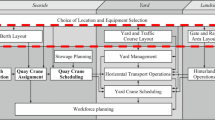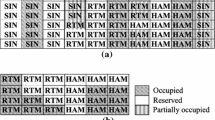Abstract
The main activities of container terminals are to load outbound containers on to vessels, discharge inbound containers from vessels, and store those containers in the yard before loading (or after discharging) them. This study proposes a method for determining an optimal layout of container yards taking into consideration the storage space requirements and throughput capacities of yard cranes and transporters. Two types of yard layout are under consideration: a layout where blocks are laid out parallel to the quay and transfer points are located beside a bay per block, and a layout whose blocks are laid out perpendicular to the quay and transfer points are located at both ends of each block. Various cost factors are used for optimizing the yard layout, which include the construction cost of the ground space, the fixed overhead cost of yard cranes, and the operating costs of yard cranes and transporters. Sensitivity analysis is performed to investigate the effect of various design parameters on the optimal layout of the yard. The two types of yard layout are compared with each other, and the results of this study are compared against those for real-world yard layouts from the perspective of throughput capacity and storage space capacity.
Similar content being viewed by others
References
Caserta M, Schwarze S, Voß S (2011a) Container rehandling at maritime container terminals. In: Böse JW (ed) Handbook of terminal planning. Springer, Berlin, pp 247–269
Caserta M, Voß S, Sniedovich M (2011) Applying the corridor method to a blocks relocation problem. OR Spectrum 33(4): 915–929
Chen T (1999) Yard operations in the container terminal—a study in the ‘unproductive moves’. Maritime Policies Manage 26(1): 27–38
de Castilho B (1993) High-throughput intermodal container terminals: technical and economic analysis of a new direct-transfer system. Proceedings of the 12th international symposium on transportation and traffic theory, Berkeley, California, USA, pp 237–254
de Castilho B, Daganzo CF (1993) Handling strategies for import containers at marine terminals. Transp Res Part B 27(2): 151–166
Gross D, Harris CM (1998) Fundamentals of queueing theory, 3rd edn. Wiley-Interscience, New York
Han Y, Lee LH, Chew EP, Tan KC (2008) A yard storage strategy for minimizing traffic congestion in a marine container transshipment hub. OR Spectrum 30(4): 697–720
Kim KH (1997) Evaluation of the number of rehandles in container yards. Comput Ind Eng 32(4): 701–711
Kim KH, Kim HB (2002) The optimal sizing of the storage space and handling facilities for import containers. Transp Res Part B 36(9): 821–835
Kim KH, Park KT (2003) A note on a dynamic space-allocation method for outbound containers. Eur J Oper Res 148(1): 92–101
Kim KH, Park YM, Jin MJ (2008) An optimal layout of container yards. OR Spectrum 30(4): 675–695
Kim KY, Kim KH (2010) Pricing the storage of inbound containers with a discrete probability distribution of retrieval times. Ind Eng Manage Syst 9(2): 165–177
Lee BK, Kim KH (2010) Comparison and evaluation of various cycle-time models for yard cranes in container terminals. Int J Prod Econ 126(2): 350–360
Lee BK, Kim KH (2010) Optimizing the block size in container yards. Transp Res Part E 46(1): 120–135
Lee BK, Kim KH, Yun WY (2011) Expressions for expectations and variances of cycle times for yard cranes by considering dependencies among time elements. Ind Eng Manage Syst 10(4): 255–263
Lee Y, Hsu NY (2007) An optimization model for the container pre-marshalling problem. Comput Oper Res 34(11): 3295–3313
Petering MEH (2009) Effect of block width and storage yard layout on marine container terminal performance. Transp Res Part E 45(4): 591–610
Petering MEH (2008) Parallel versus perpendicular yard layouts for seaport container transshipment terminals: an extensive simulation analysis. In: Proceedings of international trade and freight transportation conference, Ayia Napa, Cyprus, pp 117–127
Petering MEH, Murty KG (2009) Effect of block length and yard crane deployment systems on overall performance at a seaport container transshipment terminal. Comput and Oper Res 36(5): 1711–1725
Saanen YA (2004) An approach for designing robotized marine container terminals. PhD Dissertation, Delft University of Technolog, The Netherlands
Steenken D, Voß S, Stahlbock R (2004) Container terminal operations and operations research—a classification and literature review. OR Spectrum 26(1): 3–49
Taleb-Ibrahimi M, de Castilho B, Daganzo CF (1993) Storage space vs handling work in container terminals. Transp Res Part B 27(1): 13–32
van Hee KM, Wijbrands RJ (1988) Decision support system for container terminal planning. Eur J Oper Res 34(3): 262–272
Vidovic M, Kim KH (2006) Estimating the cycle time of three-stage material handling systems. Ann Oper Res 144(1): 181–200
Vis IFA (2006) A comparative analysis of storage and retrieval equipment at a container terminal. Int J Prod Econ 103(2): 680–693
Wiese J, Suhl L, Kliewer N (2010) Mathematical models and solution methods for optimal container terminal yard layouts. OR Spectrum 32(3): 427–452
Wiese J, Suhl L, Kliewer N (2011) Planning container terminal layouts considering equipment types and storage block design. In: Böse JW (ed) Handbook of terminal planning. Springer, Berlin, pp 219–245
Woo YJ, Kim KH (2011) Estimating the space requirement for outbound container inventories in port container terminals. Int J Prod Econ 133(1): 293–301
Zhang C, Liu J, Wan Y, Murty KG, Linn RJ (2003) Storage space allocation in container terminals. Transp Res Part B 37(10): 883–903
Author information
Authors and Affiliations
Corresponding author
Rights and permissions
About this article
Cite this article
Lee, B.K., Kim, K.H. Optimizing the yard layout in container terminals. OR Spectrum 35, 363–398 (2013). https://doi.org/10.1007/s00291-012-0298-z
Published:
Issue Date:
DOI: https://doi.org/10.1007/s00291-012-0298-z




